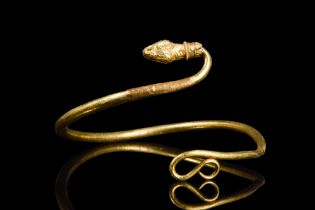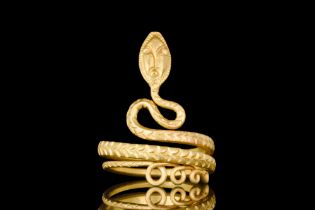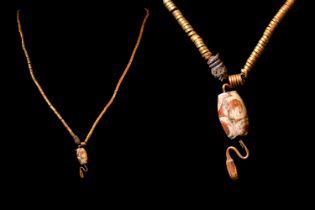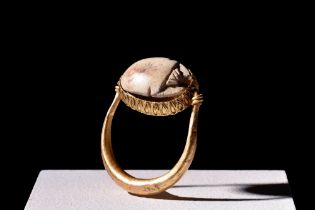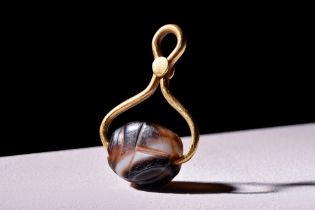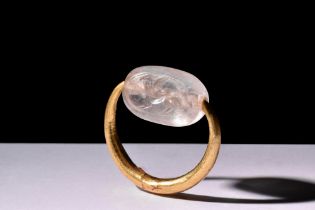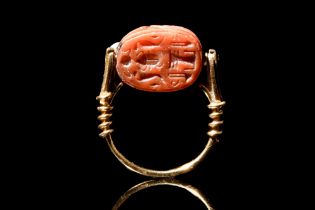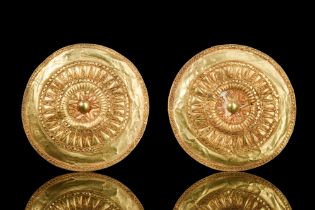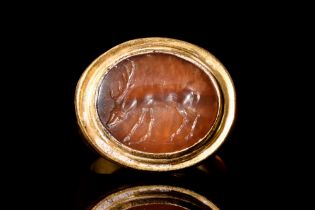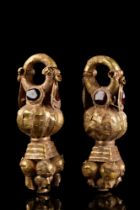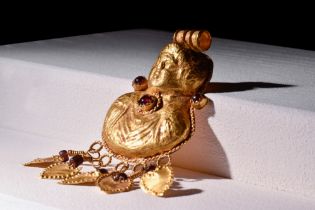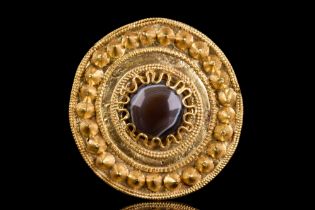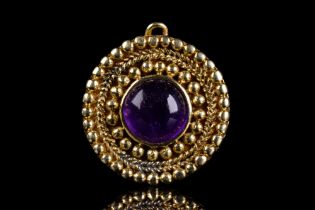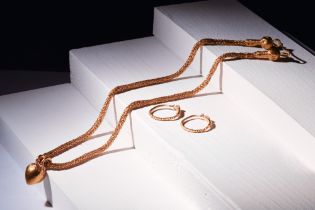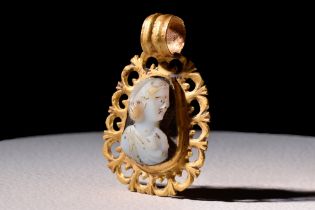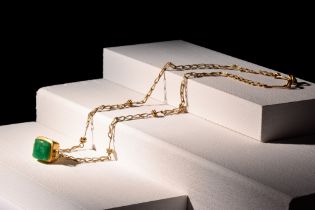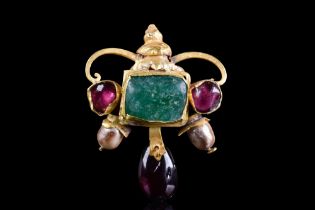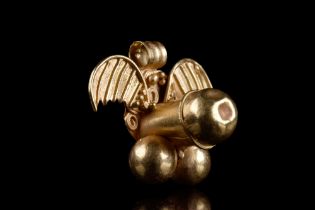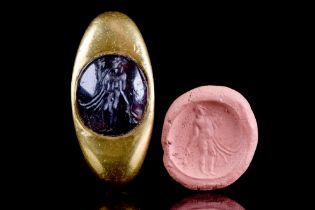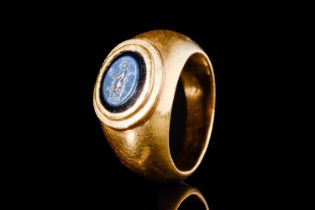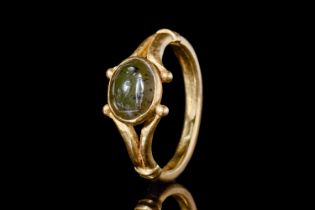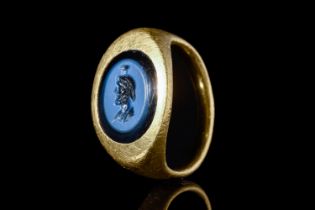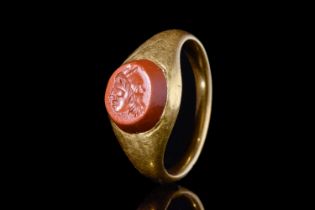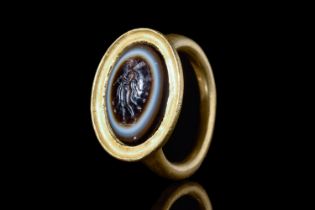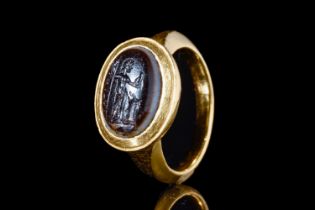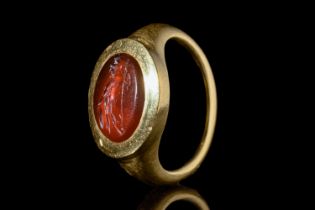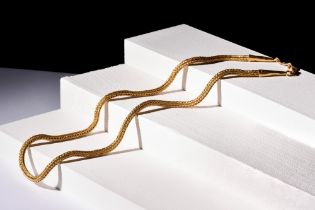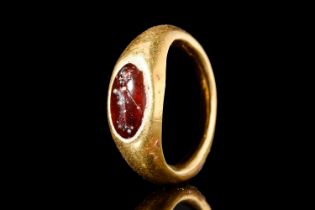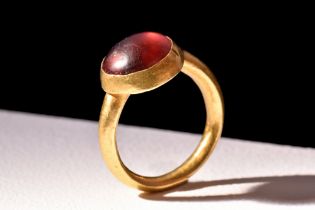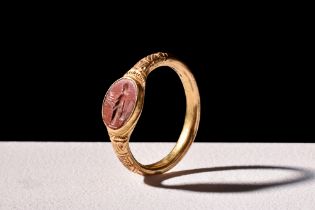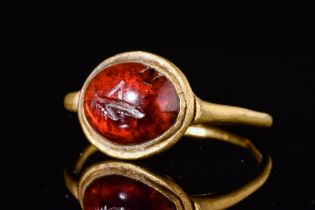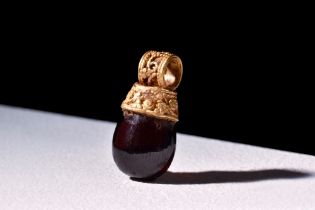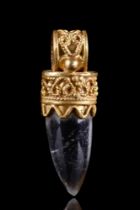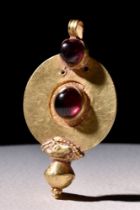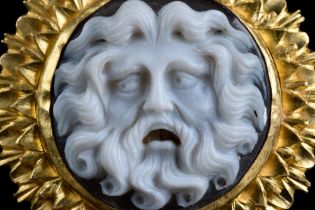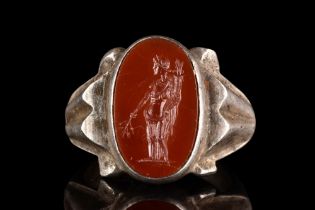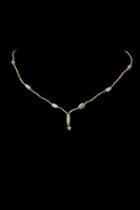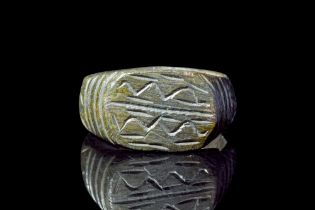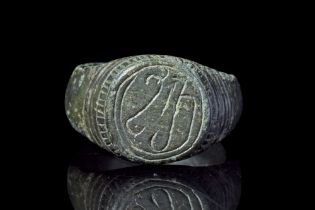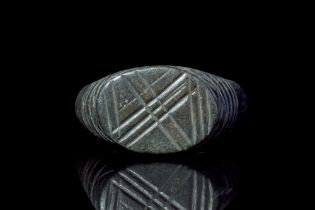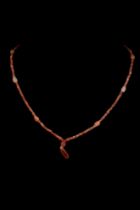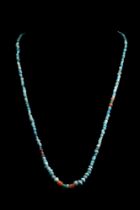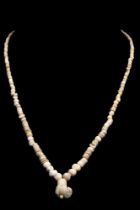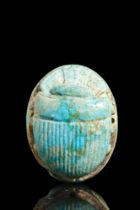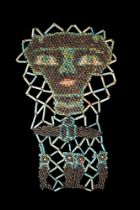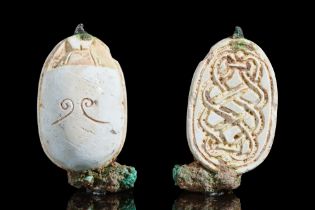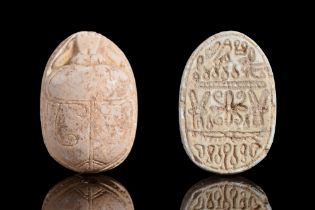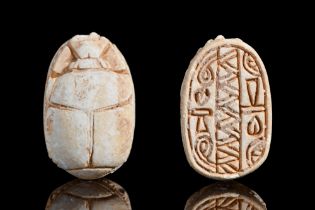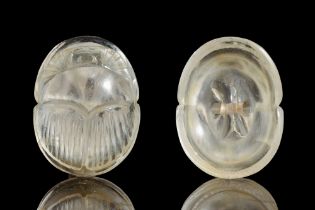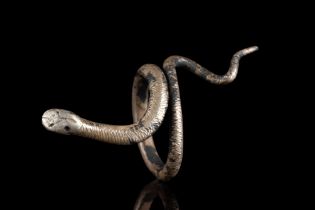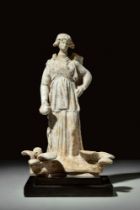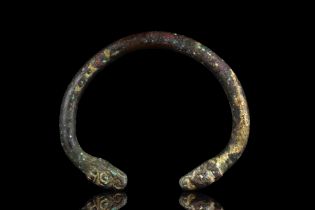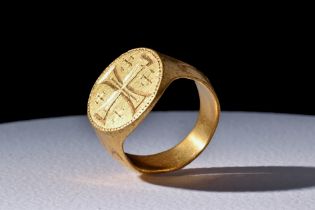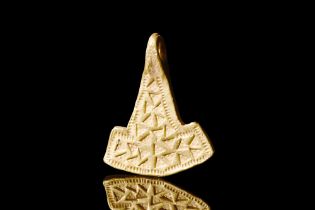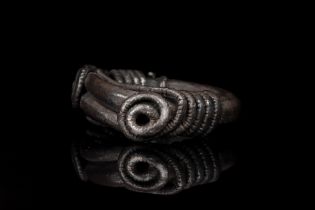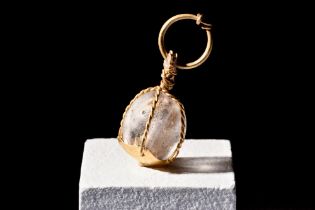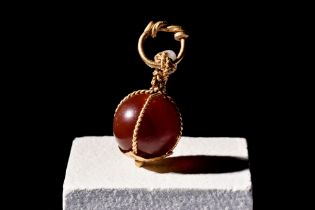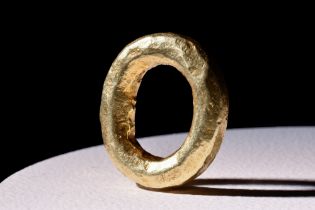Filtered by:
- Category
- List
- Grid
A subscription to the Price Guide is required to view results for auctions ten days or older. Click here for more information
Egypt, Ca. 525-30 BC.A heavy gold spiral snake arm ring, terminating with a tapered loop tail and opposing moulded snake head with one remaining b...
Ca. 100 BC-100 AD.A snake-shaped finger ring, meticulously crafted from a single piece of gold wire, tapering from tail to head with detailed eyes...
Ca. 332-30 BC.A necklace composed of a tightly coiled gold strip, centred by an agate cylinder with a drop shaped finial. Below it, a snake formed...
Hyksos Period, Ca. 1630-1523 BC.A high-karat gold swivel ring featuring a steatite scarab, a symbol of rebirth and protection. The scarab shows si...
Ca. 700-600 BC.A gold pendant holding a banded agate intaglio scaraboid depicting a finely etched horse. The golden setting, added later, compleme...
Ca. 500-400 BC.A gold swivel finger ring featuring a rock crystal scaraboid engraved with a griffin. Very well preserved and wearable. For similar...
Late Period, Ca. 664-332 BC.A vivid Egyptian carnelian scarab featuring detailed carvings, including a scarab beetle symbolising rebirth, flanked ...
Magna Graecia, Ca. 300 BC.A pair of exceptionally crafted roundel brooches. They feature intricate gold wire filigree decorations showcasing a sty...
Ca. 300-100 BC.A gold ring with a flat hoop and a sizeable bezel holding a carnelian intaglio with a detailed image of a stag. Size: D:18.34mm / U...
Ca. 400-300 BC.A pair of gold earrings featuring hollow-formed rings with hinged mechanisms, garnet embellishments, drop-shaped plaques, and tiere...
Ca. 300 BC-100 AD.A striking Greco-Roman gold pendant possibly depicting the Greek god Eros. The pendant features a suspension loop at the top and...
Ca. 400-300 BC.A gold brooch with a circular plate and a beautiful agate cabochon at the centre, skilfully secured by gold threads. On the reverse...
Ca. 300-100 BC.A finely rendered gold disc-shaped pendant, hammered from thin gold, embellished with three bands of alternating beaded and ropewor...
Ca. 400 BC. A gold chain necklace comprising a dense loop-in-loop design. The finials, culminating in distinctive mushroom-shaped terminals, with ...
Ca. 100-300 AD.A beautiful gold pendant featuring a ribbed loop and plaque with an openwork foliate border. A central cell displays a cameo bust o...
Ca. 100-300 AD. A gold chain necklace with an emerald pendant. The necklace features flat links connected by delicate filigree connectors. The pen...
Ca. 100-200 AD.A gold pendant consisting of a crowned top with curvilinear arms. The centrepiece holds a rectangular cell with a green emerald, wh...
Ca. 100-200 AD.A gold pendant displaying a winged phallus, intricately crafted with filigree and granule details. Above this intricate loop for su...
Ca. 200-100 BC.A substantial gold ring featuring broad shoulders, enclosing a convex intaglio of a standing Maenad. In Greco-Roman mythology, Maen...
Ca. 100-200 AD.A gold ring with an oval nicolo intaglio depicting Fortuna, a Roman deity symbolising destiny and luck. The ring boasts a flat-sect...
Ca. 100 AD.An oval-shaped green jasper intaglio of Faustulus leaning on his staff underneath a tree. The ring has a round hoop and graceful should...
Ca. 100-200 AD.A gold ring with a round and curved design, holding a nicolo intaglio of Serapis. The Greco-Egyptian god is linked to fertility and...
Ca. 100-200 AD.A gold ring with a rounded hoop and subtly flattened interior, holding a convex jasper intaglio. The stone is finely carved with a ...
Ca. 100-200 AD.A gold ring featuring a round-sectioned hoop and circular bezel holding a banded agate convex intaglio. The intaglio depicts Hercul...
Ca. 100-200 AD.A banded agate intaglio in a gold ring showing a detailed portrait of Jupiter holding a staff and an eagle. Size: D:19.56mm / US:9 ...
Ca. 100-200 AD.An oval carnelian intaglio depicting Mars, the Roman god of war, holding a spear and shield. For similar see: Richter, Gisela M. A....
Ca. 100-300 AD.A gold chain made with flawless round links. It has finely crafted finials with conical-shaped tubes on the ends, designed for a se...
Ca. 100-200 AD.A gold ring with a rounded hoop that comes together to hold a bezel. The stone is finely carved with a right facing portrait of Min...
Ca. 100-300 AD.A gold ring featuring an oval bloodstone with an intaglio of Victory, a figurative symbol portraying Roman military success. The st...
Ca. 100 AD.A gold ring with a red garnet cabochon in its bezel. Good condition, wearable. Size: D:15.9mm / US:5 1/4 / UK:K ; 3.64g Provenance: Fro...
Ca. 100 AD.A gold finger ring with a rounded hoop and intricate decorations on the shoulders. It holds a jasper intaglio showing Priapus, a deity ...
Ca. 100-200 AD.A gold ring characterised by its distinctive gold setting. The substantial bezel features a banded agate intaglio, carved with the ...
Ca. 100 AD.A delicate gold ring has a slender round hoop. It features a garnet cabochon with an engraved cricket. Size: D:15.49mm / US:4 3/4 / UK:...
Ca. 300-100 BC.A gold filigree pendant with a circular suspension loop, leading to a flaring body in a garnet setting. Size: L:20mm / W:10mm ; 3.3...
Ca. 300-100 BC.A gold pendant with intricate filigree work and a circular suspension loop. It contains a rock crystal cut into a claw shape. Size:...
Ca. 100-300 AD.A thin, circular gold pendant featuring a central cabochon gem held within a raised cell. Above it, another cabochon enriches the p...
Ca. 1700-1800 AD or earlier.A finely carved agate cameo depicting Oceanus, set in a gold setting. Convex in form with intricately engraved border ...
Ca. 200 AD.A silver ring with a simple circular hoop and ornate ribbed shoulders. The large bezel holds a red stone intaglio with the image of the...
Ca. 100-300 AD.A beaded necklace composed of gold and turquoise beads. A large, tubular turquoise pendant sits at the centre, adorned by a teardro...
Ca. 200-500 AD.A bronze oval-shaped ring with incised snake motifs on the bezel. The snake motifs likely symbolise healing powers in the ancient w...
Ca. 200-500 AD.A bronze ring with a flat, circular hoop, engraved decorations on the shoulders and bezel. In Roman society, these rings showed soc...
ROMAN BRONZE RING WITH 'X'
Ca. 200 AD.A bronze ring with a rounded hoop and an oval-shaped bezel engraved 'X' pattern, symbolising the number ten in Latin. Size: D:17.53mm /...
ROMAN CARNELIAN BEADED NECKLACE
Ca. 100-300 AD.A carnelian necklace with tubular and bi-conical beads, featuring a mix of dark and light hues. Carnelian was valued in ancient Rom...
ROMAN BEADED NECKLACE
Ca. 100-300 AD.A restrung necklace with stone and glass beads. It combines different materials, featuring blue and red beads. Romans esteemed blue...
ROMAN BEADED NECKLACE
Ca. 100-300 AD.A stone necklace with cream and beige beads, featuring a central pendant. Roman stone beads varied in materials and were valued for...
Late Period, Ca. 664-332 BC.A blue faience scarab with detailed features and small holes on the flat underside for attachment. Scarabs were common...
Late Period, ca. 664-332 BC.A finely crafted funerary shroud adorned with faience beads depicting the deceased's face, a winged scarab, and the fo...
Ca. 1650-1550 BC.A fine steatite scarab with naturalistic features including clypeus and prothorax marked by incised lines. Two fine lines with sw...
EGYPTIAN STEATITE SCARAB
Ca. 1650-1550 BC.A scarab formed of steatite with naturalistic features including clypeus and prothorax marked by incised lines. The reverse has b...
EGYPTIAN STEATITE SCARAB
Late Period, Ca. 664-332 BC.An ancient Egyptian steatite scarab, inscribed on the base with a geometric pattern and two flanking ankhs the symbol ...
AN EGYPTIAN ROCK CRYSTAL SCARAB
Late Period, Ca. 6640-332 BC.A naturalistically carved scarab formed of transparent rock crystal with prominent eyes, ribbed plates and clypeus or...
Ca. 100 BC-100 AD.A silver ring in the form of a coiled serpent with finely detailed scales and realistic features. The serpent symbolises renewal...
CANOSAN POTTERY LEKYTHOS FIGURE
Ca. 300 BC.A pottery figure depicticing a woman standing in contrapposto and wearing a tightly-wrapped himation over a long chiton. The drapery's ...
Ca. 800-400 BC.A bronze bracelet, composed of a circular, plain hoop, featuring decorated terminals, modelled as beast heads with large eyes and g...
Ca. 1000-1300 AD.A heavy medieval gold ring with a elaborate design, featuring a flat D-shaped hoop and a circular bezel. Inside the bezel, there ...
Ca. 900-1000 AD.A gold pendant shaped like a flat, double-headed hammer. This design is connected to 'Mjollnir,' the famous hammer of the Norse go...
Ca. 900-1000 AD.A round silver finger ring formed from twisted silver rods. Other, more delicate, silver rods are also coiled around the shoulders...
Ca. 900-1100 AD.A Viking rock cyrstal bead in possibly later high carat gold setting, comprised of woven, cage-like golden wire, twisted neatly ar...
Ca. 900-1100 AD.A Viking carnelian bead in possibly later high carat gold setting, comprised of woven, cage-like golden wire, twisted neatly aroun...
Ca. 900-1100 AD.A substantial and unusual ring, composed of twisted Viking hack gold bar. Size: D:15.49mm / US:4 3/4 / UK:J ; 38.66g Provenance: P...

